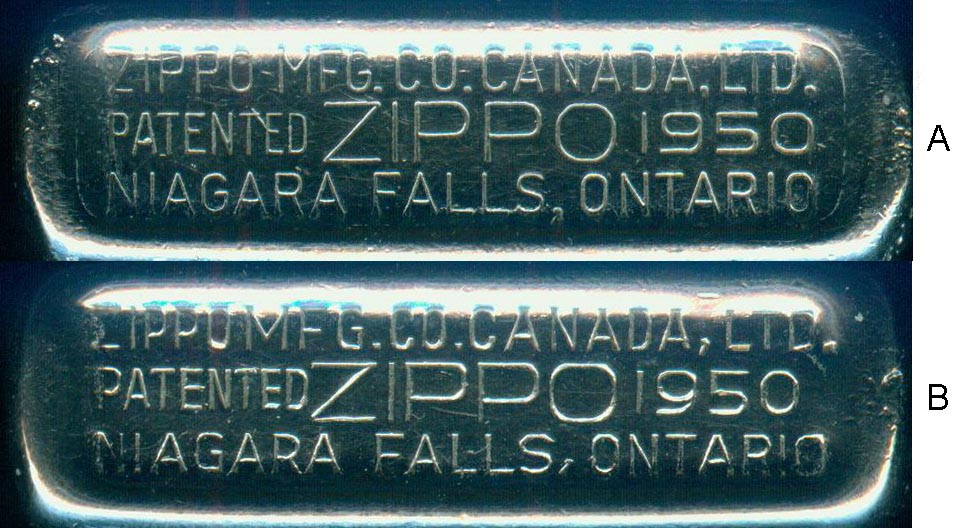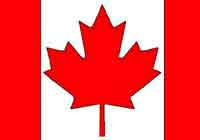
Dating Canadian Zippos

There are numerous sites around the internet that give dating charts for Zippo Lighters, and there are also dating guides in many of the Zippo Books. Dating lighters made at the Canadian factory is a little more difficult, and often confusing, but with a little detective work, many of the clues are there.
There is still much work and research to be done, and this page is by no means complete. If you can add any information please feel free to contact me
The factory in Canada opened in 1949 and closed in 2002. Codes were not used on the lighters until 1987, so we have to look closely at the bottom stamp and the insert to try to determine the date of manufacture. It is not unknown for Lighters from Canada to to be shipped with Bradford stamped inserts, so this can sometimes be a help.
The first stamp used on the base of the lighter bore the legend "PAT. PEND. This was used on lighters manufactured until around the end of 1950. The insert also had the same legend. There are many examples of "Pat Pend" cases with "Pat 1950" inserts (see below) these lighters would have been made around the time of the changeover at the end of 1950 using stock cases and newer inserts.
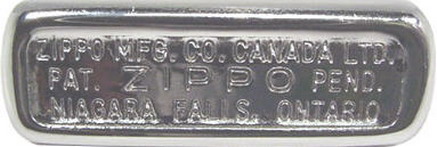 |
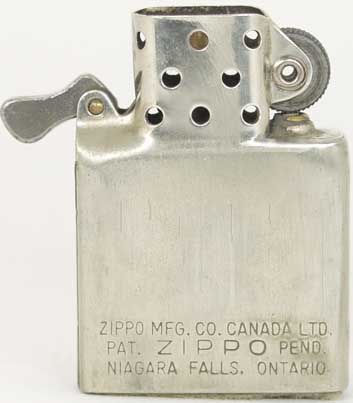 |
| 1949-1950 Canadian Base Stamp | 1949-1950 Canadian Insert |
The next bottom stamp used is the most confusing of all. The lighters were stamped "Patented 1950" and many people think that this is the year of manufacture of the lighter. This stamp was used until 1967 and a lighter with this stamp could have been made anywhere between those dates. The insert can be used to narrow down the dates a little. The early inserts would have the "Humped" cam-spring. (see photograph at bottom of page) these were used until around 1957/8. Up until 1959 the insert had just 3 lines of text at the bottom. From 1959-1963 additional text was added "FOR BEST RESULTS USE ZIPPO FLINTS AND FLUID" This was also on 3 lines higher up the insert. From 1963 to 1967 the imprint on the insert was changed changed from the horizontal (upright) to the vertical (Sideways). The flint wheel rivet can also be used to help date the lighter. The solid rivet first appeared in 1961 replacing the hollow rivets used up to that time however the hollow rivet continued to be used up until 1963. Lighters made between these dates could have either of the rivets fitted.
 |
 |
| 1951 - 1954 Canadian Base Stamp | 1951-1967 Canadian Base Stamp |
| The two bases above appear
similar at first glance, however looking particularly at "1950" we see some
differences. The shape of the 9 is different and the 0 is in a different
position compared to the second O in Ontario. Much research has been
undertaken to try to date these and it appears that the first base usually
has a nickel silver insert. This would date it to 1951-52. Some of these
have been found on lighters celebrating the 50th anniversary of a Canadian
Steel Company which was formed in 1904, therefore it is assumed that the
base was still in use up to at least 1954. It is possible
that the second base did not appear until 1952. Research is still ongoing.
Please scroll to the bottom of this page for details of the research. Similar differences are apparent on the insert (Below) The first insert uses the rounded 9 and has a comma after Canada. The second has the Squarer 9 and uses a full stop (Period) The length of the stamping is also different, this is most apparent when comparing lines 1 & 2 |
|
|
|
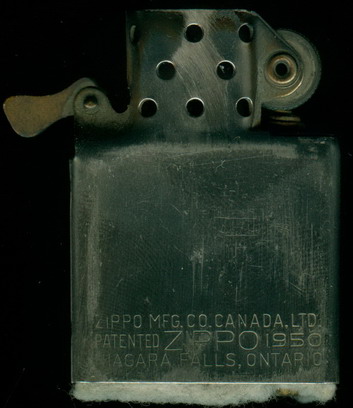 |
| 1951 - 1954 Canadian Insert | 1951-1959 Canadian Insert |
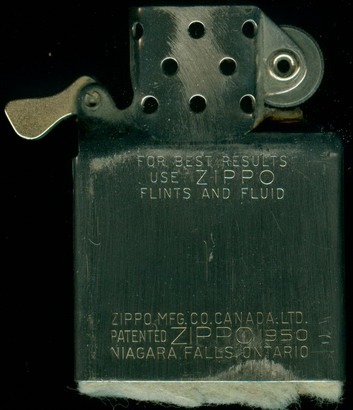 |
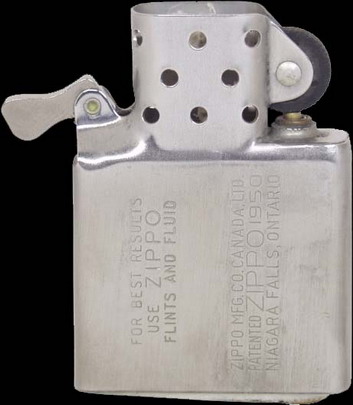 |
| 1959-1963 Canadian Insert | 1963-1967 Canadian Insert |
There is some discussion regarding the date of the removal of the 1950 stamp - see here for details
In 1967 both the base stamp and the insert changed. On the both, the words "Patented 1950" were removed. This combination was used up until 1975.
Canadian patents run for a period of 17 Years and Patent No. CA 469785 was issued on 28 November 1950. The patent therefore expired on the same date in 1967.
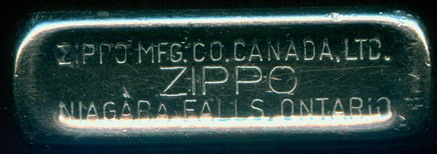 |
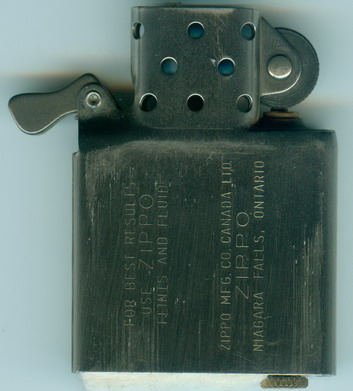 |
| 1967-1986 Canadian Base Stamp | 1967-1975 Canadian Insert |
The base stamp used from 1975 until 1986 is the same as the 1967 stamp, however in 1975 the insert was again altered being imprinted on both sides.
Around 1980 Zippo altered the wick. Wicks made after this date have copper wire entwined within the wick.
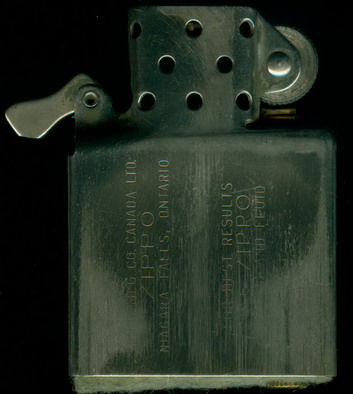 |
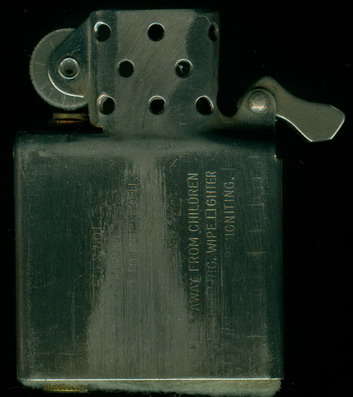 |
| 1975-1986 Canadian Insert Front | 1975-1986 Canadian Insert Reverse |
In 1987 Zippo Canada adopted the same date-coding as the US manufactured lighters with both the base stamp and the insert bearing these marks.
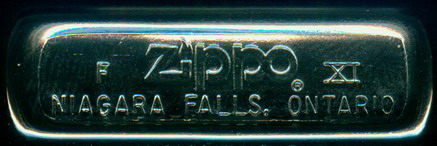 |
 |
| 1987-2002 Canadian Base Stamp | 1987-2002 Canadian Base Stamp |
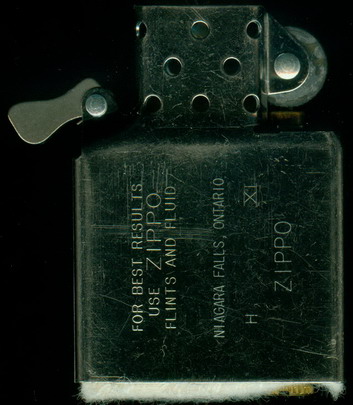 |
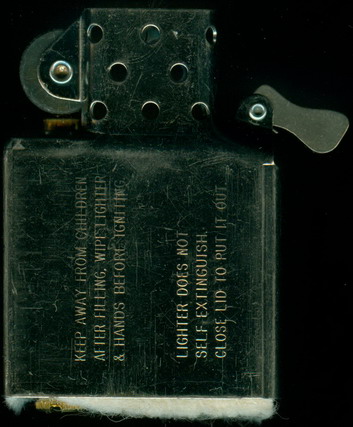 |
| 1987-1999 Canadian Insert Front | 1987-1999 Canadian Insert Reverse |
A final change to the insert was made in 2000, when the imprinting on both sides was again turned 90° to bring it back to the upright position.
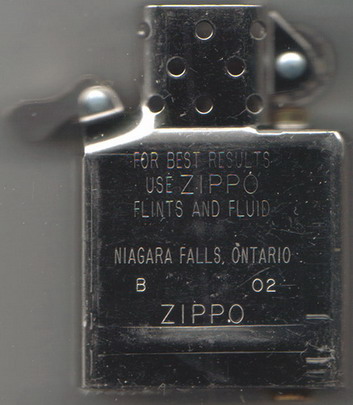 |
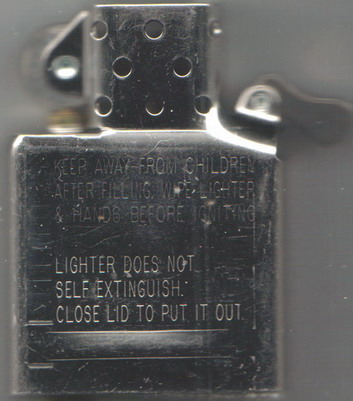 |
| 2000-2002 Canadian Insert Front | 2000-2002 Canadian Insert Reverse |
Other factors that may assist you in dating are the hinge, flint wheel rivet, and the Cam Spring. In 1955 the hinge was altered. Prior to this date all five barrels were evenly spaced. In 1955 the barrels were adjusted so that barrel 2 and 4 were slightly larger than barrels 1, 3 and 5. Hinges with equal barrels are generally classed as being manufactured up to the end of 1955, whilst unequal barrels are generally classed as 1956 and later.
Around 1961 Zippo replaced the hollow flint wheel rivet with a solid rivet. Hollow rivets continued to be used until around 1963
The cam-spring was altered twice. The first time was around 1957/8 where the "Humped" spring was replaced by a narrow, straight spring. This narrow spring continued to be used up until around 1970, whereas after this date the "widespread" cam-spring was used. The first widespread springs appeared in 1970, but narrow springs have been found in 1971 inserts.
All the dates are approximate. Some components above would be held in stock, and old stock would be used until supplies were exhausted. For this reason two lighters made on the same day could have different components fitted.
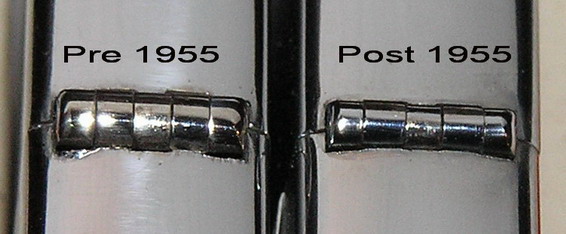 |
The hollow Rivet was used up to 1963, but the solid rivet was introduced in 1961. Between these dates either rivet could have been fitted. |
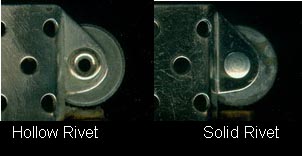 |
|
|
The early cam-springs were of the "Humped" type used from 1949 to around 1957. This was replaced by the narrow cam spring which was used until around 1970. The "widespread" spring first appeared around 1970 and continued in use until the factory closed. The lighter on the right was made after 1980 as this was the year when the copper wire was added to the wick |
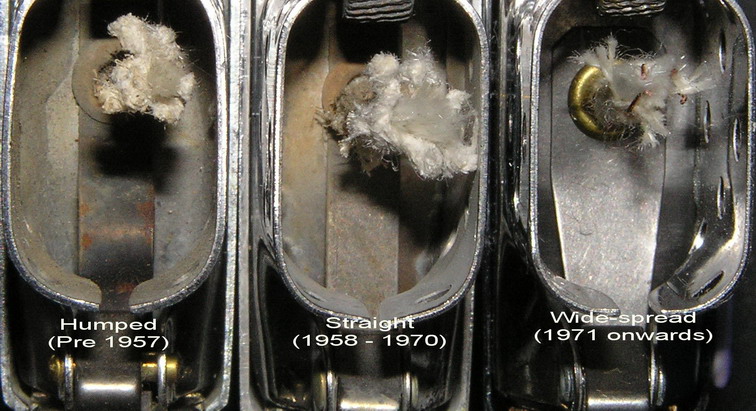 |
||
The Canadian factory closed its doors in 2002. This was commemorated with a final run limited edition lighter. Limited to only 25,000 pieces worldwide, the individually numbered silver-plated lighter signified the end of an era.
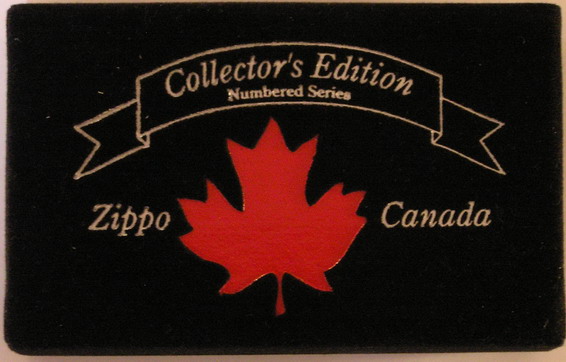 |
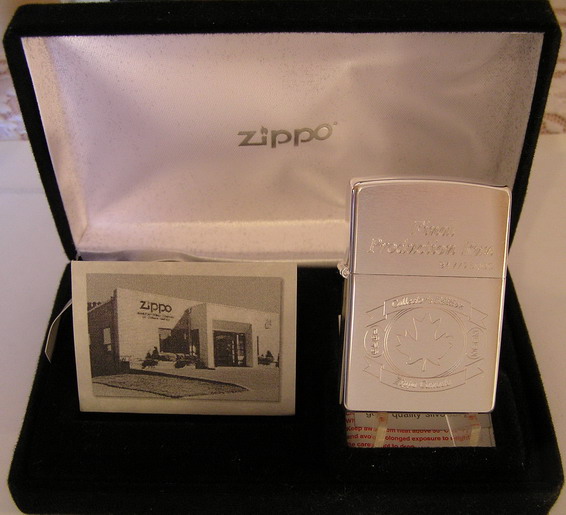 |
||
 |
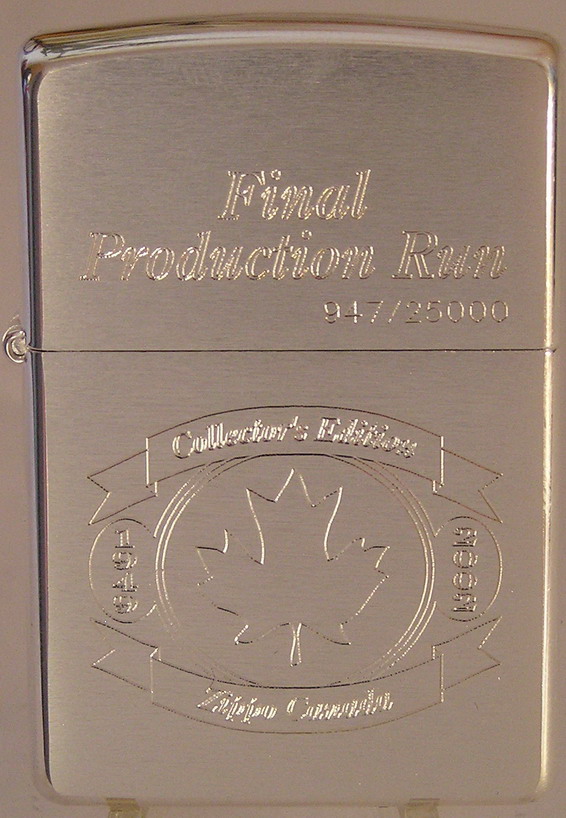 |
The Zippo plant
Niagara Falls, Ontario started business August 19, 1949 and was finally
closed July 31, 2002.
The plant was
located 6158 Allendale Ave. Niagara Falls, Ontario L2E6V9 Canada.
|
|
Quick Guide to dating Canadian Zippos
My thanks to Mike, Dave and Bob, all of whom have provided assistance with this page
Much invaluable information has been sourced from the forums of Zippo Click. There are too many contributors to these forums to thank you all individually, but reading some of the older discussions and trying to piece it all together has been fun.
16 May 2007
It has recently been noticed that there are two different versions of the Patented 1950 bottom stamp. The easiest ways to differentiate are by looking at the shape of the "9" in 1950, or by comparing the position of the 0 to the bottom line. At the present time it is not known if the different stamps were used at different times or whether they were both used throughout the period 1951 - 1967. Research is ongoing
If you own any "PAT50" lighters and would like to help with the research, please Click Here for details
